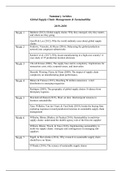Summary Articles
Global Supply Chain Management & Sustainability
2019-2020
Week 1 Baldwin (2012), Global supply chains: Why they emerged, why they matter,
and where are they going
Gereffi & Lee (2012), Why the world suddenly cares about global supply
chains
Week 2 Ferdows, Vereecke, & Meyer (2016), Delayering the global production
network into congruent subnetworks
Ketokivi et al. (2017), Why locate manufacturing in a high-cost country? A
case study of 35 production location decisions
Week 3 Choi & Krause (2006), The supply base and its complexity: Implications for
transaction costs, risks, responsiveness, and innovation
Bozarth, Warsing, Flynn, & Flynn (2009), The impact of supply chain
complexity on manufacturing plant performance,
Week 4 Blanco & Fransoo (2013), Reaching 50 million nanostores : retail
distribution in emerging megacities
Rodrigue (2009), The geography of global supply chains: Evidence from
third-party logistics
Week 5 Slawinski & Bansal (2015), Short on time: Intertemporal tensions in
business sustainability
Xiao, Wilhelm, Van der Vaart, & Van Donk (2019), Inside the buying firm:
exploring responses toward paradoxical tensions in sustainable supply chain
management
Week 6 Wilhelm, Blome, Bhakoo, & Paulraj (2016), Sustainability in multi-tier
supply chains: understand the double agency role of the first-tier supplier
Wilhem, Blome, Wieck, & Xiao (2016), Implementing sustainability in
multi-tier supply chains: strategies and contingencies in managing sub-
suppliers
Week 7 Pagell, & Shevchenko (2014), Why research in sustainable supply chain
should have no future
O’Rouke (2014), The science of sustainable supply chains
, Week 1: Introduction to global supply chains
Baldwin (2012), Global supply chains: Why they emerged, why they matter, and where are
they going.
- Why GSC’s matter, the economics of their unbundling and their implications for policy
H1: Three centuries of globalisation:
Globalisation had been driven by advances of two different types of ‘connective’
technologies: transportation and transmission,
1st unbundling: Steam made it possible, scale economies made it profitable (1830-1914)
- Production and consumption forced together by poor transportation technology
- Five top-line facts:
1) North industrialisation & South de-industrialisation
2) Growth take-off Steam production triggered to produce at vast scales, which
triggered modern growth as a self-sustaining cycle of production, innovation and
income gains.
3) ‘Big time’ international income divergence/convergence Innovation, scale
and specialisation gave Northern industry a powerful cost-advantage over industry in
South
4) International trade & labour migration boomed
5) Production clustered locally as it dispersed globally:
- Globalisation’s paradox solved in 3 points:
1. Cheap transport favours large-scale production
2. Such production is complex
3. Extreme proximity lowers the cost of coordinating the complexity (more
important).
2nd unbundling: ICT made it possible, wage differences made it profitable (1980- ?)
- Coordinating production complex exchanges among stages in the production process, so
bundling all stages in a single factory reduces costs and risks
- ‘Coordinating glue’ communication throughout ICT:
- ICT revolution made it possible to coordinate complexity at distance.
- The vast wage differences between developed and developing nations made separation
profitable.
Schematic illustration of coordination costs and the 2nd unbundling
,Most technology is firm specific internationalising = offshoring know-how. There are
different measures of supply chain internationalisation:
1) Focussing on products where nations are exporting and importing extraordinarily
much, this contradicts the 1st unbundling because nations seem to have comparative
advantage and disadvantage. The sum of the overlapping trade as a fraction of world
manufacturing trade provides a measure for supply-chain trade.
2) Using nations’ input-output matrices to identify which goods are inputs into which
industries; identifying the imports which are intermediate inputs and summing this up
to get a measure of supply-chain trade. (estimation of nations’ export share made up of
value added from intermediate inputs form its trade partners).
Backward linkages matrix:
- ‘Headquarter’ economies; exports contain relatively little imported
intermediates.
- ‘Factory’ economies; exports contain a large share of imported intermediates.
2nd unbundling impact:
Transformed the world economy and continues to do so today
- Five top-line facts:
1) Reversal of the big income divergence: Offshoring of labour-intensive stages of
manufacturing and heightened international mobility of technology produced
spectacular growth in emerging markets whose economic reforms fostered and were
fostered by the rapid industrialisation.
2) South industrialisation & North de-industrialisation: growth of Asia’s
industrialisation.
3) Rise of 21st century trade: the trade-investment-services-IP nexus:
- Internationalising supply chains internationalised the complex two-way flows
that
take place in factories. 21st century trade is in intertwining of:
- Trade in goods (parts/components)
- International investment in production facilities, training, technology & long-
term relationships
- Use of infrastructure services to coordinate the dispersed production (ICT)
- Cross-border flows of know-how
4) New industrialisation path: joining rather than building ind. Supply chains
= emerging market economies by developing nations
5) New political economy of liberalisation
Easier to become a part of a market
H2: Economics of supply chain unbundling
> Porter (1985), told firms to focus on what they do best and to outsource for the rest 2nd
globalisation shifted locus of globalisation form sectors to stages of production, so better to
, look at 1) fractionalisation; finer stages of production and 2) dispersion; geographic
unbundling of stages.
Functional dimension (TOPS framework)
Useful to view the SC at 4 levels of aggregation: products, stages, occupations and tasks
Tasks full list of everything that needs to be done
Occupation group of tasks performed by an individual worker
Stages collection of occupations that are performed in close proximity due to the need for
face 2 face interaction, fragility of the partially processed goods etc.
Specialisation vs. coordinating and risks
Splitting up tasks = harder to coordinate. The optimal allocation of tasks to occupations is
governed by the trade-off between specialisation and coordination. Good coordination
technology favours fewer tasks per occupation and fewer occupations per stage.
ICT affects the optimal division of labour via two channels:
- Communication and organisational technologies; facilitate transmission of ideas,
instructions and information
- Information technology makes it easier for individual workers to master more tasks.





